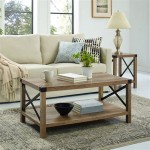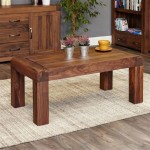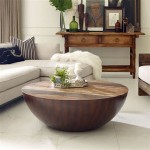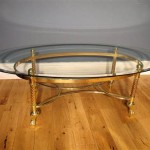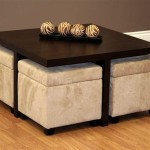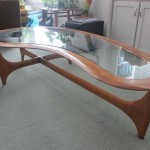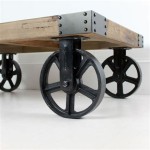A Guide To Choosing The Perfect White Oak Coffee Table Round
White oak coffee tables are a popular choice for homeowners seeking a blend of durability, natural beauty, and versatility. The round configuration offers a softer aesthetic compared to rectangular or square tables, promoting conversation and enhancing traffic flow in living spaces. Selecting the "perfect" white oak coffee table round, however, requires careful consideration of several factors, from wood grade and finish to size and style. This guide provides a comprehensive overview to assist in making an informed decision that complements individual needs and preferences.
Understanding White Oak Properties and Grading
White oak, scientifically known as *Quercus alba*, is highly regarded for its strength, density, and resistance to decay. Its closed-grain structure makes it less porous than red oak, rendering it suitable for both indoor and outdoor applications. The inherent tannin content contributes to its durability and resistance to moisture, minimizing warping and cracking over time. These properties make white oak an excellent choice for furniture pieces subjected to everyday use, such as coffee tables.
White oak lumber is graded based on appearance and the presence of imperfections. Grading systems, often established by organizations like the National Hardwood Lumber Association (NHLA), categorize lumber into grades such as FAS (Firsts and Seconds), Select, and Common. FAS grade represents the highest quality, characterized by large, clear cuttings with minimal knots or defects. Select grade is similar to FAS but allows for slightly smaller board sizes. Common grades contain more knots, mineral streaks, and other imperfections, resulting in a more rustic aesthetic. The grade of white oak used in constructing a coffee table significantly impacts its visual appeal and potentially its structural integrity.
When choosing a white oak coffee table, understanding the wood grade allows aligning aesthetic preferences with budget considerations. Tables crafted from FAS or Select grade lumber will typically command a higher price due to the superior quality and appearance of the wood. However, lower grades can offer a unique, character-rich look that appeals to those seeking a more rustic or vintage style. Inspecting images or, preferably, examining the table in person helps assess the wood's grain pattern, knot placement, and overall visual characteristics.
Determining the Appropriate Size and Height
The size and height of a coffee table are crucial considerations that impact its functionality and the overall balance of the living room. A coffee table that is too large can overwhelm the space and impede movement, while a table that is too small may not provide adequate surface area for its intended purpose. The height of the table should also be proportional to the height of the surrounding seating, allowing for comfortable access and use.
As a general guideline, the coffee table should be approximately two-thirds the length of the sofa. This proportion creates visual harmony and ensures that the table does not dominate the room. For a sectional sofa, the coffee table should be slightly longer than two-thirds the length of the longest section. The space between the sofa and the coffee table should be between 14 and 18 inches. This spacing allows for comfortable legroom and easy access to the table. Less spacing might cause difficulty moving around, while more spacing makes it hard to reach the coffee table.
The height of the coffee table should be approximately the same height as the sofa cushions or slightly lower. This height ensures that the table is easily accessible from a seated position. A coffee table that is too high can feel awkward to use, while a table that is too low may require excessive bending. When choosing a round coffee table, consider the diameter carefully. A larger diameter provides more surface area but may also require more space. Measure the available space accurately and consider the traffic flow in the room before making a decision. Using painter's tape to mark the intended footprint of the coffee table on the floor can aid in visualizing its impact on the space.
Exploring Finish Options and Their Impact
The finish applied to a white oak coffee table not only protects the wood but also significantly influences its appearance and durability. Various finish options are available, each offering distinct characteristics and aesthetic qualities. Understanding the different types of finishes and their impact on the wood can help select the most appropriate option for specific needs and preferences.
Common finish options for white oak include oil finishes, lacquer finishes, varnish finishes, and polyurethane finishes. Oil finishes, such as tung oil or linseed oil, penetrate the wood, enhancing its natural grain and providing a soft, matte sheen. Oil finishes are relatively easy to apply and maintain but offer less protection against moisture and scratches compared to other options. Lacquer finishes create a durable, hard surface that is resistant to scratches and stains. They are available in various sheens, from matte to high-gloss, allowing for customization of the table's appearance. However, lacquer finishes can be more challenging to apply and repair compared to oil finishes.
Varnish finishes provide a durable, water-resistant surface that is suitable for high-traffic areas. They are available in various formulations, including spar varnish, which is specifically designed for outdoor use. Polyurethane finishes offer the highest level of protection against moisture, scratches, and chemicals. They are available in both water-based and oil-based formulations, with water-based options being more environmentally friendly. The choice of finish depends on the desired aesthetic, the level of protection required, and the ease of application and maintenance. Consider the overall style of the room and surrounding furniture when selecting a finish to create a cohesive and harmonious look.
Analyzing Styles and Design Elements
White oak coffee tables are available in various styles, ranging from traditional to contemporary, each offering distinct design elements and aesthetic characteristics. The style of the coffee table should complement the overall design of the living room and reflect individual preferences. Understanding the different styles and their defining features can help select a table that harmonizes with the existing décor.
Traditional styles often feature ornate details, such as carved legs, decorative aprons, and intricate moldings. These tables typically incorporate classic design elements and are often finished with a rich, warm stain. Contemporary styles emphasize clean lines, minimalist forms, and a focus on functionality. These tables often feature simple, geometric shapes and are finished with a light, natural stain or a painted finish. Mid-century modern styles combine elements of both traditional and contemporary design, featuring clean lines, tapered legs, and a focus on natural materials. These tables often incorporate walnut or other contrasting woods and are finished with a clear, satin finish.
In addition to the overall style, consider the design elements of the coffee table, such as the shape of the legs, the presence of a shelf or drawers, and the type of edge detail. Tapered legs create a sense of lightness and elegance, while chunky, block legs provide a more substantial and grounded look. A shelf or drawers offer additional storage space for books, magazines, or remote controls. The edge detail can range from a simple, square edge to a more decorative, rounded or beveled edge. Paying attention to these details ensures that the coffee table is both functional and aesthetically pleasing.
Considering Sustainability and Ethical Sourcing
In recent years, there has been increasing awareness of the importance of sustainability and ethical sourcing in the furniture industry. Choosing a white oak coffee table made from sustainably harvested wood and produced under ethical labor practices is a responsible decision that supports environmental conservation and social justice.
Look for certifications from organizations such as the Forest Stewardship Council (FSC), which ensures that the wood is sourced from responsibly managed forests. FSC-certified forests are managed to protect biodiversity, water quality, and the rights of indigenous peoples. In addition to wood sourcing, consider the manufacturing practices of the company. Look for companies that prioritize energy efficiency, waste reduction, and the use of non-toxic materials. Supporting companies that embrace sustainable practices helps minimize the environmental impact of furniture production.
Ethical labor practices are also an important consideration. Ensure that the coffee table is produced in factories that provide fair wages, safe working conditions, and respect for workers' rights. Transparency in the supply chain is essential for verifying ethical labor practices. Look for companies that are willing to disclose information about their manufacturing processes and labor standards. By choosing a white oak coffee table made from sustainably sourced wood and produced under ethical labor practices, one can contribute to a more responsible and sustainable furniture industry.

Field Coffee Table Round White Oak Sundays Company

Field Coffee Table Round White Oak Sundays Company

Field Coffee Table Round White Oak Sundays Company

How To Pick A Coffee Table 105 Picks For Every Space

Clairemont Natural Oak Wood 48 Round Coffee Table With Shelf Reviews Crate Barrel

Beautiful Coffee Table Ideas And Trends For 2024 Jane At Home

Simple Round Coffee Tables Under 600 Allisa Jacobs

Buy Edge Round Coffee Table Oak By Rj Living

Coffee Table Guide Furniture

Wood Glass Nesting Coffee Table Set Oak Living Room Accent Tables Round
Related Posts


